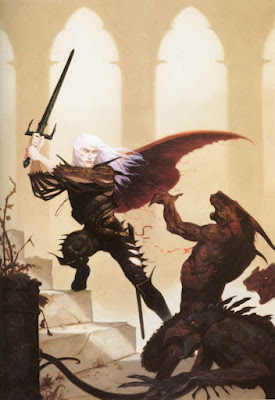All this talk about Dungeon23 has put me in the mood to write some posts about megadungeon design, not as a tutorial exactly (I wouldn't begin to call it anything as presumptuous as that) but more as a kind of worked example that others may find interesting.
The posts in the series will (as currently envisaged) be:
1. The concept (a somewhat unified thematic approach being crucial, I think, to giving a dungeon coherence and verisimilitude)
2. Rough maps of levels and contents
3. Keying
4. Random encounters
Concept first, then. As mentioned above, it's important for a good dungeon to be based around a set of basic themes that will guide both the design and contents. Partly this is simply because it makes it easier to come up with everything that follows (rather than having a random smorgasbord of contents without rhyme or reason). Partly it is because it gives the players the feeling that the PCs are actually in a real environment, that exists for a reason. And partly it is just more interesting for the DM to actually design - it keeps one motivated.
By 'themes', I am referring to very loose, guiding principles that inform the planning process - not hard and fast rules, and certainly not details or concrete elements. We are talking, in essence, about the framework within which the actual planning of the dungeon will take place. This will become more clear as we go on.
Themes can be grouped, I would suggest, into the historical, structural and aesthetic.
A historical theme gives the dungeon its backstory and environment. By this, I don't mean a complete history or timeline or even anything very concrete - remember, this is a theme only. I mean, rather, something akin to an elevator pitch - a thumbnail descriptor of what the dungeon is and where it comes from. For instance, the dungeon I will use for this worked example is one I will call Lost Eskinoot, Palace of the Artificiers. Here, the historical theme is encapsulated in the title: a palace within which there one dwelt a group, guild or cult known as the 'artificiers', who from their title we can assume were in the business of making things through 'artifice' - perhaps having a magical element. This, in turn, suggests to me a vaguely science-fantasy world.
A structural theme gives the dungeon its basic design. Here, I am thinking, again, not in detail - certainly not at the level of individual rooms or structures - but a rough idea of the overall layout, perhaps with a particularly unusual shape in mind. For Lost Eskinoot, Palace of the Artificiers I have in mind the kind of maze that you often find in kids' toys, in which the child manipulates the maze itself this way and that in order to get a ball to the centre. This suggests a basic design of concentric circles, each corresponding to a different level of the dungeon, with certain 'choke points' between each circle where transit is allowed. Something along these lines:
Finally, an aesthetic theme is what the youth of today might call a 'vibe' - a governing mood or feeling. For Lost Eskinoot, this, riffing on the science-fantasy motif, is very much rooted in the pulp tradition, and designed to channel what I have elsewhere called 'fantastical fantasy':
So that is what I mean by a concept - an imaginative palette, so to speak, giving the dungeon a reason for being, a basic physical outline, and a steer towards content. In the next post, I'll turn to the process of mapping.










I love the thoughtful approach to tying the themes together. I've been thinking more about how the dungeon affects the surface area above it, & vice versa.
ReplyDeleteI'll add these tips to the list!